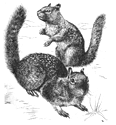Vertebrate Pest Conference Proceedings collection
Date of this Version
March 1976
Document Type
Article
Abstract
Damage to coniferous seedlings and trees by forest rodents, including forest lagomorphs, is a major factor limiting prompt regeneration and causing significant losses in young stands. Manipulating the vegetation to adversely influence food and cover thereby reducing animal numbers is proposed as an approach to alleviating damage. The adaptability, high reproductive potential, opportunistic feeding behavior, and mobility of forest rodents combined with the species diversity of rodent communities, rapid recovery of vegetation, and need for long-term protection make habitat manipulation for damage control a difficult approach. However, an example is presented where herbicide-induced reduction in vegetative cover and availability of summer foods resulted in a significant reduction of clipping damage to Douglas-fir seedlings by snowshoe hares.

